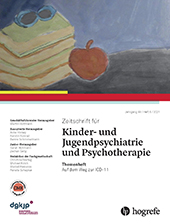Die Konzeption von Persönlichkeitsstörungen in der ICD-11
Abstract
Zusammenfassung. Die Klassifikation von Persönlichkeitsstörungen (PS) als voneinander unterscheidbare Kategorien wird in der ICD-11 ersetzt durch eine dimensionale Einordnung mit Schweregradabstufungen. Ob eine PS vorliegt oder nicht, wird über Beeinträchtigungen von selbstbezogenen und interpersonellen Persönlichkeitsfunktionen definiert. Alle PS-Diagnosen, mit Ausnahme der Borderline-PS wurden aufgehoben, sodass es in der ICD-11 nur noch die Kategorie „Persönlichkeitsstörung“ (ICD-11 Code 6D10) gibt, die bei Vorliegen der Kriterien einer Borderline-PS durch einen sogenannten „Trait-Qualifier“ ergänzt werden kann. Alle anderen Formen von PS werden durch spezifische Profile von fünf pathologischen Persönlichkeits-Traits charakterisiert. Die zentralste Veränderung aus Sicht der Kinder- und Jugendpsychiatrie besteht darin, dass die Altersgrenze für die Diagnose einer PS aufgehoben wurde, sodass die Störung und ihre Entwicklung nun vergleichbar zu anderen psychiatrischen Störungen in einer Perspektive über die Lebensspanne hinweg gesehen wird.
Abstract. In ICD-11, the classification of personality disorders (PD) is no longer categorical but dimensional, along a spectrum defined by the severity of the disorder. The definition of PD is based on the level of impairment of self-directed and interpersonal personality functioning. Only one general diagnostic category “Personality Disorder” remains (ICD-11 Code 6D10). All distinct PD diagnoses from ICD-10 are missing, with the exception of Borderline PD, which can be classified with a “trait qualifier.” The type of PD is characterized by specific patterns of five maladaptive personality traits. From the perspective of child and adolescent psychiatry, the most important change from ICD-10 to ICD-11 is the removal of an age limit, meaning PDs can be diagnosed across the lifespan.
Literatur
American Psychiatric Association . (2013). Diagnostic and Statistical Manual of Mental Disorders Fifth Edition (DSM-5). Arlington, VA: American Psychiatric Association.(2020). Structure of clinician-reported ICD-11 personality disorder trait qualifiers. Psychological Assessment, 32, 50–59.
(2020). International assessment of DSM-5 and ICD-11 personality disorder traits: Toward a common nosology in DSM-5.1. PsyArXiv Preprint. https://doi.org/10.31234/osf.io/qcwsb
(2017). Deriving ICD-11 personality disorder domains from dsm-5 traits: Initial attempt to harmonize two diagnostic systems. Acta Psychiatrica Scandinavica, 136, 108–117.
(2020). Assessment of the ICD-11 dimensional trait model: An introduction to the special section. Psychological Assessment, 32, 1–7.
. (2017). Prevention and early intervention for borderline personality disorder: A novel public health priority. World Psychiatry, 16, 215–216.
(2015). ESCAP expert article: Borderline personality disorder in adolescence: An expert research review with implications for clinical practice. European Child & Adolescent Psychiatry, 24, 1307–1320.
(2013). Saving Normal. An insider´s look at what caused the epidemic of mental illness and how to cure it. New York: William Morrow.
(2013). The DSM-5 dimensional trait model and five-factor models of general personality. Journal of Abnormal Psychology, 122, 816–821.
(2018). Assessment of personality functioning in adolescents with the LoPF-Q 12–18 self-report questionnaire. Journal of Personality Assessment, 100, 680–690.
(2011). Ten-year course of borderline personality disorder: Psychopathology and function from the Collaborative Longitudinal Personality Disorders Study. Archives of General Psychiatry, 68, 827–837.
(2019). Mental health professionals’ perceived clinical utility of the ICD-10 vs. ICD-11 classification of personality disorders. Personality of Mental Health, 13, 84–95.
(2018). Neue Wege der Klassifikation von Persönlichkeitsstörungen in ICD-11. Fortschritte der Neurologie · Psychiatrie, 86, 150–155.
(2017). The challenge of transforming the diagnostic system of personality disorders. Journal of Personality Disorders, 31, 577–589.
(2017). Health related quality of life and psychopathological distress in risk taking and self-harming adolescents with full-syndrome, subthreshold and without borderline personality disorder: Rethinking the clinical cut-off? Borderline Personality Disorder and Emotion Dysregulation, 4, 7.
(2020). Development of a short and reliable measure for maladaptive personality traits according to DSM-5 and ICD-11 using ant colony optimization algorithms. PsyArXiv Preprint. https://doi.org.10.31234/osf.io/rsw54
(2020). A comprehensive comparison of the ICD-11 and DSM-5 section III personality disorder models. Psychological Assessment, 32, 72–84.
(2018). Development and psychometric properties of the Standardized Assessment of Severity of Personality Disorder (SASPD). Journal of Personal Disorders, 32, 44–56.
(2018). A self-report measure for the ICD-11 dimensional trait model proposal: The personality inventory for ICD-11. Psychological Assessment, 30, 154–169.
(2019). Evaluating the assessment of the ICD-11 personality disorder diagnostic system. Psychological Assessment, 31, 674–684.
(2014). Persönlichkeit, akzentuierte Wesenszüge und Persönlichkeitsstörungen. Ein Beitrag zur dimensionalen Diagnostik von Persönlichkeitsstörungen. Der Nervenarzt, 73, 247–254.
(2014). DSM-5: Das Konzept der Persönlichkeitsstörungen aus kinder- und jugendpsychiatrischer Sicht. Persönlichkeitsstörungen Theorie und Therapie, 18, 6–15.
(2020). Validation of personality inventory for DSM-5 (PID-5) algorithms to assess ICD-11 personality trait domains in a psychiatric sample. Psychological Assessment, 32, 40–49
(2019). Zeit für etwas Neues? Paradigmenwechsel für die Persönlichkeitsstörung im ICD-11. Überblick und Chancen für das Jugendalter. Persönlichkeitsstörungen, 23, 299–309.
(2015). Practitioner review: Borderline personality disorder in adolescence –recent conceptualization, intervention, and implications for clinical practice. Journal of Child Psychology and Psychiatry, 56, 1266–1288.
(2019). The development of the ICD-11 classification of personality disorders: An amalgam of science, pragmatism, and politics. Annual Revue of Clinical Psychology, 15, 481–502.
(2019). A life span perspective on borderline personality disorder. Current Psychiatry Reports, 21, 51.
(2019). Problems with the ICD-11 classification of personality disorder. Lancet Psychiatry, 6, 461–463.
(2009). An integrative dimensional classification of personality disorder. Psychological Assessment, 21, 243–255.
World Health Organization . (2019). International Classification of Diseases 11th Revision (ICD-11). Verfügbar unter: https://icd.who.int/browse11/l-m/en(2012). Attainment and stability of sustained symptomatic remission and recovery among patients with borderline personality disorder and axis II comparison subjects: A 16-year prospective follow-up study. American Journal of Psychiatry, 169, 476–483.



